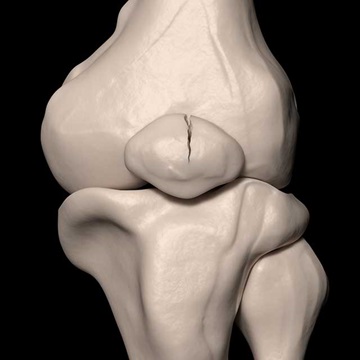Kneecap Fractures (Patella Fractures)
What You Need to Know
- Patella (kneecap) fractures (broken kneecap) are common injuries. About 1% of all broken bones are broken kneecaps.
- Fractures of the patella are most often caused by a direct blow to the knee, such as a fall or motor vehicle accident.
- Kneecap fractures can be simple or complex. Complicated patella fractures, which result in displaced pieces of bone, may require surgery.
- Rehabilitation focuses on improving range of motion, building up muscle strength and decreasing knee stiffness. Recovery can take several months.

What is a kneecap fracture?
A kneecap (patella) fracture is a break of the bone located on the front of the knee joint. The patella is a sesamoid bone: a round bone embedded in a tendon that shields and protects a joint. In the case of the patella, ligaments attach it to both the thigh muscles (quadriceps) and the shinbone (tibia).
In some cases, kneecap fractures can be accompanied by injuries to knee tendons and ligaments due to the initial impact to the knee.
Types of Kneecap Fractures
The type of patella fracture depends on the mechanism and severity of the injury. It can be affected by your weight and general health.
Displaced and Nondisplaced Kneecap Fractures
- Nondisplaced kneecap fractures occur when the patella is broken but hasn’t moved out of place.
- In displaced patella fractures, the patella is broken and the pieces of bone have moved out of place.
Closed and Open Kneecap Fractures
- A kneecap fracture is considered closed if the broken pieces of patella do not pierce the skin.
- In open kneecap fractures, the bones stick out of the skin, creating a complex wound.
Comminuted, Noncomminuted and Hairline Kneecap Fractures
- A comminuted patella fracture is one in which the bone is shattered into three or more pieces.
- In a noncomminuted patella fracture, the kneecap is broken in two pieces.
- A hairline kneecap fracture is a simple crack in the bone (the patella is still in one piece). Hairline fractures are also known as stress fractures, and are rare in the kneecap. They can occur in athletes, such as marathon runners, and may be due to overuse. A stress fracture of the patella may be difficult to see on an X-ray. The main symptom is pain in the front of the knee that gets worse over time.
Patellar Sleeve Fractures
Patellar sleeve injuries can affect children, most commonly between ages 8 and 12 when the bony portion of the knee is still forming. The injury happens when the bony part of the patella gets pulled out of its sleeve of cartilage. The bone is not broken, so technically this is not a fracture, although it is treated in a similar manner.
What causes kneecap fractures?
Patella fractures are injuries often associated with a blow to the knee. Common causes include:
- Falling directly on the knee, especially on a hard surface such as concrete
- Sports where the knee may be directly hit by a ball, bat or stick
- Car accidents where the knee hits the dashboard
- Gunshot wounds
- Sudden contractions (pulling) of the quadriceps muscle that causes the tendon to pull on the kneecap and break it apart
Kneecap Fracture Symptoms
The symptoms of a patella fracture may include:
- Pain around the kneecap or in the knee
- Bruising
- Swelling, which can be severe, even with relatively minor kneecap fractures
- Inability to bend or straighten the knee or to hold the leg out straight
- Inability to bear weight, stand or walk
- Deformed appearance of the knee, especially with severe fractures
- Bone protruding from the skin of the knee in the case of an open patellar fracture
If you have these symptoms after hitting or injuring your knee or leg, call your doctor or visit an urgent care clinic for an examination.
Kneecap Fracture Diagnosis
Your doctor may use some of the following techniques to determine if you have fractured your patella:
- History: The doctor will ask you about any recent trauma, such as sports injuries, automobile accidents or falls.
- Physical examination: The doctor will examine the knee and check for deformity that can be felt through the skin such as gaps or edges of bone.
- The doctor may put mild pressure on the kneecap, and may bend or straighten the leg to see if those actions cause or increase pain or reveal a deformity.
- X-rays help the doctor identify a fracture and see if there are fragments.
Treatment for a Fractured Kneecap
Treatment for patella fracture varies depending on how severe the break is, as well as your age, health and other factors.
Urgent Care
Patella fractures can cause extensive bleeding into the joint. Emergency treatment may include draining blood and fluid from the joint to reduce swelling and pain and to make it easier to diagnose the problem.
Nonsurgical Treatments
Nonsurgical treatment is typically recommended for more stable patellar fractures or less severe breaks and may include:
- A cast or splint to hold the leg in place while the bone heals
- Preventing or reducing weight-bearing
- Pain medications (opioid pain medication may be appropriate for the first few days after a severe kneecap fracture, followed by non-opioid options)
- Physical therapy and walking aids to help you regain strength and independence.
Kneecap Repair Surgery
Surgical treatment is typically recommended for more severe kneecap fractures. Surgical repairs may:
- Use screws, pins and wires to hold larger pieces of patella together
- Remove fragments of bone that are too small to reattach. In very severe comminuted fractures, removal of part or all of the kneecap may be necessary, but the surgeon will attempt to preserve and reattach as much of the kneecap as possible.
- Address damage to the patellar ligament and other structures in the knee joint associated with the fracture (for example, in the case of an open fracture where bone pieces have damaged the skin and soft tissue)
Recovery and Complications After a Patella Fracture
The knee is a complex joint that bears weight. Even after treatment, you may experience continued pain and reduced range of motion. Post-traumatic arthritis (thinning of cartilage due to trauma) of the knee is a common complication of patella fractures and other knee injuries.
After weeks or months of immobilization with a cast or splint, there may be muscle loss (atrophy) in the leg. Physical therapy can help minimize atrophy and prevent it from becoming permanent, as well as recover muscle strength, flexibility and range of motion. Physical therapy and occupational therapy may also be recommended if you had surgery to repair the kneecap.
Depending on your age and health, it takes about three to six months to recover from a broken kneecap, but very severe patellar injuries may take longer.
For a time, you may be advised to avoid climbing stairs, squatting, kneeling or other activities that place strain on the knee joint. In most cases, you should still be able to walk with a fractured kneecap while the knee is immobilized and healing. Your care team will recommend exercises and weight-bearing restrictions appropriate for each stage of recovery.
Persistent pain or severe post-traumatic osteoarthritis in the knee can call for continued reassessment and further surgery, including knee replacement.





